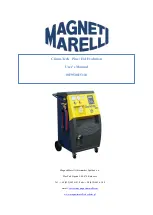
14
the electrode from the clamp after welding.
If you wish to adjust the Hot-start (LED
AM
) and Arc force
functions (LED
AN
), see the previous paragraph.
3.5
TIG WELDING
This welding machine is suitable for welding stainless steel,
iron, or copper using the TIG procedure.
Connect the earth cable connector to the positive pole (+) of
the welding machine, and the clamp to the workpiece as
close as possible to the welding point, making sure there is
good electrical contact.
Connect the power connector of the TIG torch to the nega-
tive pole (-) of the welding machine.
Connect the torch connector to the welding machine con-
nector
Y
.
Connect the torch gas hose fitting to the fitting
Z
on the
machine, and the gas hose from the cylinder pressure regu-
lator to the gas fitting
AD
on the rear panel.
3.5.1 Cooling unit
If using a water-cooled torch, use the cooling unit.
3.5.1.1 Explanation of technical specifications
U1
Rated supply voltage
1x400V
Single-phase power supply
50/60 Hz
Frequency
I1max
Maximum absorbed current
Pmax
Maximum pressure
P (1l/min)
Refrigerant power measured at 1L/min
3.5.1.2 Description of protections
- Coolant pressure protection
This protection is achieved by means of a pressure swit-
ch, inserted in the fluid delivery circuit, which controls a
microswitch.
- Fuse
(T 2A/250V-Ø 5x20)
This fuse was inserted to protect the pump.
3.51.3 Installation
Unscrew the cap and fill the tank (the equipment is supplied
with approximately one liter of fluid).
It is important to periodically check, through the slot, that the
fluid remains at the "max" level.
As a coolant, use water (preferably deionized) mixed with
alcohol in percentages defined according to the following table:
temperature water/alcohol
0°C up to -5°C
4L/1L
-5°C up to -10°C
3.8L/1.2L
NOTE If the pump turns with no coolant present, you must
remove all air from the tubes.
If so, turn off the power source, disconnect the torche hoses,
fill the tank, connect a hose to the fitting (
), Insert the
other end of the hose in the tank. Start the power source for
approximately 10/15 seconds, then connect the torche
hoses.
Turn on the machine. To select the operating mode of the
cooling unit, proceed as follows:
1. Select any TIG welding mode.
2. Press the key
Q
and, while holding it down, press the
key
R
. Keep them pressed until the abbreviation H2O
appears on the display
P
.
3. Select the operating mode using the knob
O
, keeping in
mind that the numbers that appear on the display
N
have the following meaning:
1 = Unit off,
2 = Continuous operation,
3 = Automatic operation.
To exit selection, briefly press the key Q.
NOTE
: "Automatic mode" means that the cooling unit starts
when the torch button is pressed and stops running approx-
imately 2 minutes after the torch button is released.
Warning!
If MMA electrode welding is selected, cooling is not
on and may not be selected. It is normal for the machine display
P
to display, on start-up, the flashing abbreviation H2O.
3.5.1.4 Cooling unit for Art. 339
If using a water-cooled torch, use the cooling unit.
The trolley Art. 1432 is required to position and transport the
welding machine together with the cooling unit.
After filling the tank with coolant, connect the plug of the
mains cable to the socket
AE
of the welding machine, then
connect the 3-pin male patch connector to the connector
AF
.
2.5.1.5 Description of the cooling unit for Art.341
(Fig. 3)
AG - Slot:
Slot to inspect the coolant fluid level
AH - Quick-fitting sockets:
Use only for TIG welding systems.
NOTE: they must not be linked together.
AI - Cap.
Turn on the machine.
Do not touch live parts and output terminals while the
machine is powered.
The first time the machine is turned on, select the mode
using the push-button
A
and the welding parameters by
means of the key
R
and the knob
O
as described in para-
graph 3.2.
The flow of inert gas must be set to a value (in liters per
minute) approximately 6 times the diameter of the electrode.
If you are using gas-lens type accessories, the gas through-
put may be reduced to approximately 3 times the diameter
of the electrode. The diameter of the ceramic nozzle must be
4 to 6 times the diameter of the electrode.
The most commonly used gas is normally ARGON, because
it is less costly than other inert gases, but you may also use
AH
AI
AG
Fig. 3
Содержание TIG SOUND DC 3240/T
Страница 87: ...87 Art 339 ...
Страница 88: ...88 Art 341 ...
Страница 91: ...91 Art 339 ...
Страница 96: ...96 ...















































